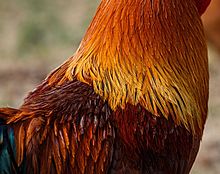
Hackles are the erectile plumage or hair in the neck area of some birds and mammals.
In birds, the hackle is the group of feathers found along the back and side of the neck. The hackles of some types of chicken, particularly roosters, are long, fine, and often brightly coloured. These hackles may be used in fly fishing as lures.

In mammals, the hackles are the hairs of the neck and back which become erect when the animal is fearful, as part of the fight-or-flight response, or to show dominance over subordinate animals. Raising the hackles causes the animal to appear larger, and acts as a visual warning to other animals. Raised hackles are used by grey wolves as a dominance behavior, by moose preparing to attack, and by cats and striped hyena which are fearful or threatened. The process by which the hair is raised is called piloerection. The contraction of the arrector pili muscle associated with each hair follicle causes the hair to become erect.
See also
References
- Damerow, Gail (2012). The Chicken Encyclopedia: An Illustrated Reference. Storey Publishing. p. 137. ISBN 9781603427760.
- ^ Damerow, Gail (2010). "Chapter 1: Choosing a breed". Guide to Raising. Storey Publishing. p. 20. ISBN 9781603424691.
- ^ Hudson, Lola; Hamilton, William (2017). "Arrector pili muscles". Atlas of Feline Anatomy For Veterinarians. CRC Press. ISBN 9781351465311.
- Dallas, Sue; Ackerman, Nicola (2016). "Chapter 6. Canine and feline anatomy and physiology". In Ackerman, Nicola; Aspinall, Victoria (eds.). Aspinall's Complete Textbook of Veterinary Nursing. Elsevier Health Sciences. p. 111. ISBN 9780702066092.
- Svartberg, Kenth; Forkman, Björn (October 20, 2002). "Personality traits in the domestic dog (Canis familiaris)" (PDF). Applied Animal Behaviour Science. 79 (2): 133–155. doi:10.1016/s0168-1591(02)00121-1.
- James Serpell, ed. (1999). The domestic dog : its evolution, behaviour, and interactions with people. pencil drawings by Priscilla Barrett (Repr. ed.). Cambridge, England: Cambridge University Press. p. 118. ISBN 9780521425377.
- Colorado Parks and Wildlife (2018-10-15), Moose Attacks Are Increasing, archived from the original on 2021-12-20, retrieved 2018-10-24
- Estes, Richard D. (1999). The Safari Companion: A Guide to Watching African Mammals Including Hoofed Mammals, Carnivores, and Primates. Chelsea Green Publishing. p. 286. ISBN 9781603581851.
- Taibo, Angela (2014). "Chapter 11: The integumentary system". Veterinary Medical Terminology: Guide and Workbook. John Wiley & Sons. ISBN 9781118774670.
External links
 The dictionary definition of hackle at Wiktionary
The dictionary definition of hackle at Wiktionary